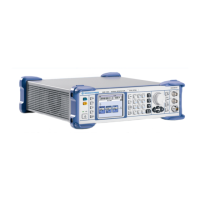Instrument Function
R&S
®
SMB100A
146Operating Manual 1407.0806.32 ─ 13
The averaging filter is used to reduce fluctuations in the measured result to the extent
desired. Such fluctuations can be caused by inherent noise of the measuring instrument,
modulation of the measurement signal or beats from the superposition of adjacent car-
riers. A more stable display has to be traded off against longer measurements. The mea-
surement result is obtained from a two-stage averaging process.
Note: Longer measurements does not mean that it takes longer to display a new result,
but rather that it takes longer for the result to settle when the power changes.
Measurements are continuously repeated in a predefined time window. The measure-
ment result is obtained by averaging the measured values for the last 2N time windows.
The number N is the filter length, the factor of 2 arises because the output signals from
the microwave detector to suppress low-frequency noise are chopped at the same rate
as the time windows, which means that an independent measured value can only be
obtained from two consecutive values. As the filter length is the multiplier for the time
window it directly influences the measurement time.
The filter length can be selected automatically or can be manually set to a fixed value.
As a preliminary, you should always check if the auto mode is giving satisfactory results
because you will always have to adjust an optimal, manual filter-length setting if the power
is not constant.
Selection "Fixed Noise" is offered for reaching defined measurement accuracy.
"Auto"
The filter length is automatically selected and adapted to the currently
measured value. With very high signals the filter length and therefore
the measurement time can be short. With very low signal levels the filter
length and therefore the measurement time is increased in order to
reduce noise. The used filter length is indicated in the field to the right.
"User"
The filter length is set manually.
The filter length is entered in the entry window to the right. As the filter
length works as a multiplier for the time window, this results in a con-
stant measurement time. Values 1 and 2^n are settable.
Note: The time window varies depending on the used sensor. For most
sensors it is fixed to 20 ms. For the R&S NRP-Z81 sensor it is 10 us.
Therefore, the user filter length for the R&S NRP-Z81 has be about
1000 times larger than the filter length for other sensors in order to
achieve the same filtering result.
The "Auto Once" button can be used to search for the optimum filter
length for the current measurement conditions. The found filter length
is indicated in the field to the right.
"Fixed Noise"
The averaging factor is selected so that the sensor's intrinsic noise (2
standard deviations) does not exceed the specified noise content.
The desired noise content is entered in the entry field to the right.
To avoid very long settling times when the power is low, the averaging
factor can be limited with the "Timeout" parameter.
Remote command:
:SENSe<ch>[:POWer]:FILTer:TYPE on page 283
:SENSe<ch>[:POWer]:FILTer:LENGth:AUTO? on page 281
:SENSe<ch>[:POWer]:FILTer:LENGth[:USER] on page 281
:SENSe<ch>[:POWer]:FILTer:NSRatio on page 282
:SENSe<ch>[:POWer]:FILTer:NSRatio:MTIMe on page 282
RF Block

